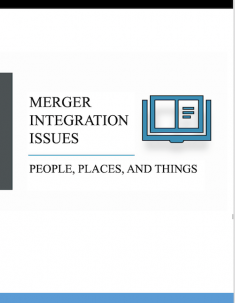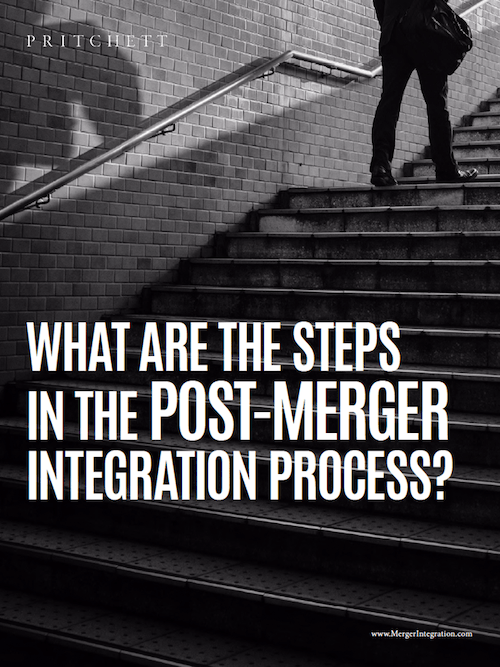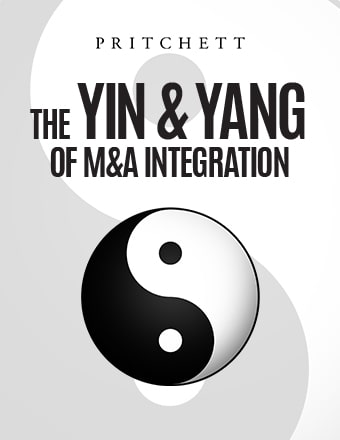In attempting to realize the true value of a merger, the buyer must coordinate a smooth and efficient merger integration process. Important issues need to be addressed in three areas—people, places, and things.
People
Staffing Level
One of the primary areas that an acquiring company looks to in order to realize the projected return on its investment is the new company’s staffing level. If employee redundancies are eliminated, cost projections are more likely to be met. The hard part is deciding who stays and who goes. Much of this depends on the nature of the acquisition. If the intent is for an acquired firm is to maintain its independence, it might make little sense to reduce staffing levels. However, if the acquired firm is absorbed into the acquirer, staff cutbacks may be appropriate.
Management
The staffing decisions process is normally driven by the acquiring company, but it is a good practice to involve the acquired company so a comprehensive evaluation be made. Candidates must be evaluated objectively which can be difficult to do because emotions can cloud the judgment of evaluators. For the acquirer, it is much easier to just stick with the team it knows and has worked with for years. But failure to consider acquired company personnel for management positions reduces the chances of success.
Labor
Rank and file employees are protected by labor laws. This may limit the options available when deciding who should stay and who should go. However, it should not prevent the buyer from assessing all employees. By evaluating first and then worrying about possible legal protections, the buyer gains a much better sense of the quality of the workforce.
The same evaluation guidelines apply to both labor and management. The buyer should be objective, balanced, and honest and develop a selection methodology by targeting certain employees for layoff or retention based on performance and experience. The applied criteria should be documented, supported by a performance evaluation, and kept confidential. The process may require the formation of a review committee made up of representatives from each company to ensure that any terminations occur according to agreed upon procedures.
Once the selections are made, they must be examined in light of the law. The following is a list of legal considerations to be examined:
- Employment agreements that may contain conditions that are unacceptable to the buyer or conditions that may be triggered in the event of a merger or acquisition
- Employees on family leave, pregnancy leave, workers’ compensation, or disability who have certain rights to comparable positions upon their return to work, which may or may not be consistent with staffing plans after the acquisition
- Whistle-blowers who could bring claims of wrongful discharge
- WARN (Workers Adjustment and Retraining Notification) notices, which must be sent out 60 days in advance by the seller to its employees if there is a plan to close facilities
- Race, religion, sex discrimination for which the buyer may be held accountable under civil rights legislation, even if claims are filed based on events that occurred before the acquisition
- Age discrimination under the Age Discrimination in Employment Act (ADEA) and/or Older Workers Benefit Protection Act (OWBPA), which protects workers against changes in the workforce or changes in benefit plans that would discriminate against workers over forty or make age-based distinctions
- Compliance with the Americans with Disabilities Act (ADA), which among other things, requires a review of job descriptions to ensure that there is a distinction between essential and nonessential duties and a review of property leases to determine who is responsible (the lessee or the lessor) for renovations required under the ADA
- Violations of the Fair Labor Standards Act (FLSA) or Equal Pay Act, especially concerning the determination of exempt versus nonexempt positions; a violation in this area could lead to substantial payments to current and former employees for overtime worked but not paid
- Problems that could develop under the Occupational Health and Safety Act (OSHA) if current compliance is not verified and the cost of future compliance is not factored into operating results
- If the employees being acquired are legally able to work in the United States; the burden of compliance is on the employer under the Immigration Reform and Control Act (IRCA)
- If there is compliance with the Drug-Free Workplace Act and various government contract laws, since lack of compliance can lead to suspended payments or terminated contracts for a seller that is a federal government contractor
- Whether state law counterparts to federal employment laws have precedence
Bottom line, the buyer needs to conduct a thorough review of employment law. This entails all manner of documents related to such issues. Each transaction is unique; the above issues will apply to different situations in different degrees.
Creating a New Management Team
Adding talent from the acquired management team could make the acquirer’s management team stronger than it was before. Discussing the post-close management structure before the purchase is finalized can help reduce harsh feelings down the road by ensuring parties know their post-close roles.
Redundancies
If both of the companies are in the same geographic location, or they will be moved into one place after the sale, redundancies can probably be eliminated in certain areas. If, on the other hand, the companies will be located geographically far from each other, the buyer might find that separate support staffs are required to make daily operations function smoothly.
When possible, the acquiring company should develop a staffing plan before the sale is finalized. Otherwise, the chances are higher it will struggle with the prior owners, their employees, and others after the deal closes.
Sales and Marketing
The sales and marketing people, and processes, must be closely examined before an acquisition is completed. These people make hundreds of little decisions every day, and these all add up to sales success or failure. They must understand what they can and cannot expect from the combination of the companies.
If current customers of both companies are expected to react favorably to a combined sales/marketing effort, then it may make sense to integrate right away. However, if an acquirer combines two sales functions that have completely different skill sets, this may cost the buyer sales and customers.
In any event, making no changes to the sales process might sacrifice cross-selling opportunities and add unnecessary costs. The buyer should determine the best way to sell to customers and then structure the sales/marketing/support functions so that an optimal approach is taken.
Customers
It is important for the seller to transfer the goodwill of its customers to the buyer. A disgruntled customer-facing employee can very quickly destroy company goodwill and perhaps jeopardize a significant income streams on which the value of the acquisition was based.
The key steps to transferring goodwill are:
- Personal introductions to customer contacts
- Social events to acquaint customers with the new owners
- Letters from both the seller and buyer that thank customers for their business and announce the new management and plans for the merged entity
Keep in mind, some customers may not be worth retaining if the relationship is unprofitable or the customer has no strategic value.
Vendors
A buyer should conduct a thorough review of the existing suppliers to ensure that the seller is getting the best prices and terms. There may be certain suppliers whose replacement would cause significant disruption. Essential vendors are a key component of the continued success and uninterrupted operations of a company.
Of special importance are suppliers that provide professional services – in particular, bankers, accountants, and lawyers. The standard assumption is that the combined company will use the buyer’s professional suppliers, but this may not always be desirable. For example, the legal counsel of the seller may be better suited to deal with certain local matters or be more cost effective. The accountants of the seller may be providing outsourcing of certain tasks for which it may not be practical to terminate immediately. These factors should be considered carefully before any key relationships are cancelled, and it may be best to continue to use both firms for certain purposes, subject to any potential conflicts of interest being resolved.
Culture
“The due diligence was friendly. The negotiations were cordial. All has gone well. Now, let’s get on with the business. And by the way, I think we’ll do all things our way. After all, we are the buyer.”
This approach may damage relationships if the acquired company interprets this as a lack of respect for its past and culture
There are four key steps to make sure culture issues don’t threaten the success of an otherwise wonderful marriage.
- First, factor cultural differences into the value of the deal
- Second, realize that the cultures of both companies are important
- Third, figure out how to align on the same goals
There is less cultural friction when companies converge on the same goals.
No matter how similar businesses are, they always have cultural differences. Intense differences often lead to decreased productivity, lower revenues and income, and a lower return from the deal. As a result, it is often wise to place a conservative value on the first year’s earnings and cash flow. After that, the value should depend on the experience the buyer has obtained as a result of prior acquisitions. If this is the first acquisition and there is no staff with experience in such matters, the buyer would be well served to also estimate conservatively in future years.
Benefits and Compensation Plans
With the Employee Retirement Income Security Act (ERISA), and other such legislation concerned with compensation and benefits, managing the merging of benefit and compensation plans has taken on added importance. All of the issues concerned with benefit and compensation plans should be worked out in the course of negotiations. Failure to do so, especially pension plans concerns, can result in costly surprises that cannot be readily addressed afterwards.
As a result of the elaborate structure of such plans, the primary concern should be the ERISA-covered plans – in particular, defined benefit pension plans. The options available for ERISA-covered pension plans (defined benefit as well as defined contribution) include terminating the existing plan, freezing the benefits accrued up to the acquisition, merging the two companies’ plans, maintaining two plans, or converting to an entirely different plan. Each of these options has benefits and pitfalls, but the primary issue is the potential costs. The costs include required contributions, the amount of unfounded liabilities (in the case of defined benefit plans), and cash flow requirements. Only after evaluating the magnitude of these costs can an educated decision be made as to which course to take.
Another issue to consider is the integration of other compensation and benefit components, such as medical, life, and disability insurance; severance policies; and reimbursement of medical and child-care expenses. As with ERISA-covered plans, the options available are similar – maintain separate systems, choose one system over the other, or choose a combination of the two systems. The method of integration chosen is often driven by the costs involved, but it should also take into account the overall compensation and benefits philosophy.
Believe it or not, making the above choices is the easy part. The hard part comes with the closing of the transaction and the need to integrate the plans of the two companies. The first step is to set the objectives of the integration. The objectives should cover factors such as the cost, funding, adequacy, and competitive position of the plan.
Once objectives have been set, the pre-merger plans of both companies should be reviewed relative to the objectives outlined for the choice made. In addition, the option chosen should be compared to the general marketplace. Finally, the plan should be evaluated by a representative group of employees. Assuming the plan has passed all of the above tests, it is now time to implement. As with most post-close issues, implementation determines success or failure.
The key to successful implementation of benefit and compensation plans is communication. Without good communication of the plan’s objectives and details, implementation will be moderately successful, at very best.
Company Identity
Now that the two companies have become one, it only stands to reason that the merged entity is different from what existed before. Yet this point can often be forgotten. Since there is essentially a new company, it may be important to consider a new corporate identity in the form of the company name and/or logo.
A corporate identity defines what makes a corporation unique. The company name and logo are merely manifestations of that identity. Before such issues can be decided, it must be determined what the corporation stands for, where it is going, and how it is different from other organizations. Only then does it make sense to put a name on it.
There are several aspects of a business that go into its identity. These include market share, industry group identification, customer base, employees, and direction. Most, if not all, of these aspects are altered in some way as a result of a merger or acquisition. The key is to identify what changes have occurred and respond to them by shaping the image or identity that will be communicated to the public.
Legal Issues
Following the closing of the transaction, there are many legal and administrative tasks that must be accomplished by the acquisition team to complete the transaction. The nature and extent of these tasks will vary, depending on size and type of the financing method selected by the buyer. The parties to any acquisition must be careful to ensure that the jubilation of closing does not cause any post-closing matters to be overlooked.
In an asset acquisition, these post-closing tasks typically include the following:
- Final verification that all assets acquired are free of liens and encumbrances
- Recording of financial statements and transfer tax returns
- Recording of any assignments of intellectual property with the Library of Congress or Patent and Trademark Office
- Notification of the sale to employees, customers, distributors, and suppliers
- Adjustments to bank accounts and insurance policies
In addition to the above, a stock acquisition may also include the following:
- Filing articles of amendment to the corporate charter or articles of merger
- Completion of the transfer of all stock certificates
- Amendments to the corporate bylaws
- Preparation of all appropriate post-closing minutes and resolutions
Places
Locations
When competitors combine, there are often location issues. Two highly competitive companies might be located in contiguous or nearby areas. If the two companies merge into a single entity, the second location may become unnecessary since it will now sell the same products, at the same price, along with the same services as the first. If one of them has to go, which one should it be? Once again, it is a matter of individual assessment, but it’s usually best to go with the better location/better sales company.
If the companies are consolidated, the buyer will need to fully inform its customers about any changes to location and names.
Space requirements also deserve attention. When examining the space requirements of the combined entity, determine if the rent is more or less expensive than other company’s space and if the amount of space is more than is needed.
There are also human considerations. How long have the employees been in this space? How does the commute compare to where they might be relocated? How much interaction is required between the staff being relocated and the staff in a different location? How much reconfiguration of the office and facilities of each company will be required to accommodate additional staff or functions? How much employee productivity may be lost during the course of the move?
Location is a factor that can affect overall integration success and can lead to significant turnover. It is taken very personally by many employees. This, of course, does not mean that the buyer should not take steps to maximize the efficiency of the space or to dispose of the property when appropriate. But it does mean that all factors need to be carefully considered.
Things
Technology Issues
In today’s world, you have to evaluate technology costs, or you could be in store for some unwelcome, expensive, and disruptive surprises. Almost every aspect of a company is in some way dependent on technology. Changing technologies is never easy or cheap and is always disruptive.
The buyer should not ignore and assume technology differences will just “work themselves out” after close. Lack of technical compatibility will make an integration much longer and more difficult.
Operations Technologies
Acquirer’s need to determine what aspects of the acquiree’s operations are dependent on technology, and if it is standard or proprietary technology. If the acquirer’s internal systems cannot merge with those of the acquired company, then it will likely have to purchase a new or updated version that allows for the right level of integration. Not integrating systems might substantially diminish the benefits expected by purchasing the company
Operations might also include special software applications. If the software is proprietary, the buyer will need to determine the upgrade cost so that integration is possible or investigate purchasing a completely new system.
Communication Technologies
Critical business operations might be heavily dependent on the office phones, cell phones, the Internet, or other communications-related technology. Email, websites, 800 numbers, and laptop computers are all critical components.
Assume that both companies use 800 numbers for providing service and taking orders. What happens to these 800 numbers and the people and systems who answer them when companies merge? How are customers trained to dial one or the other number? It is amazing the impact simply changing a phone number can have. Letterhead stationery web site information, and product literature, brochures, advertising, business cards, and numerous other daily necessities need updating whenever contact information changes. This is an expensive process, but it is necessary when changing a company’s identity or method of contact, so buyers should not forget to include it in their transition plan.
If the companies plan to consolidate web sites, they must think about how to handle referring people from the former web sites to the new one. Do you want them automatically referred or do you want to train them to go to the new site? When they enter the new web site, do they automatically come in at the parent company’s home page or do they go to a subpage? All of these questions must be answered to ensure a smooth and painless transition for the company’s electronic customers.
Accounting Systems
Setting up the financial systems of the two companies is a lot like setting up the operational systems. Tracking information must be based on the business model chosen as part of the purchase process.
If the two companies are to be treated as separate entities, accounting can remain relatively distinct. Perhaps, only the data required for the preparation of consolidated financial reports may be exchanged. Once you merge companies, you must account for the assets, liabilities, income, and expenses of the two organizations. Automating and streamlining the consolidation of financial data is necessary to provide the financial reports required to run the company.
Financial reporting will usually have to be addressed right after close. Here are a few areas the buyer should consider regarding accounting systems:
- Invoicing and accounts receivable must be integrated if you plan to consolidate sales and marketing force efforts.
- Vendor relations and information should also be consolidated if you plan to consolidate operations. Keeping separate ordering, payment, and receipt databases is a sure way to have future problems with vendors.
- At some point your employee records will have to be consolidated in a merged environment, so you might as well plan this process from the beginning.
There is no way for the buyer to determine if his recent purchase is performing up to expectations if he doesn’t have valid accounting and financial information. Making sure that these systems provide the information needed, in a credible and consistent manner, helps spot acquisition integration problems earlier in the process, instead of later.
Merging Customer Databases
A determination about whether or not to combine customer database information is really predicated in large part on what the buyer’s strategic decisions are. The cost of overcoming the technology hurdles associated with combining databases may be greater than the expected benefits. On the other hand, combining databases may be the best way for salespeople to share leads. Once again, there is no right or wrong answer. Buyers must think about which solution will best optimize their ability to use their sales force and customer information most effectively.





